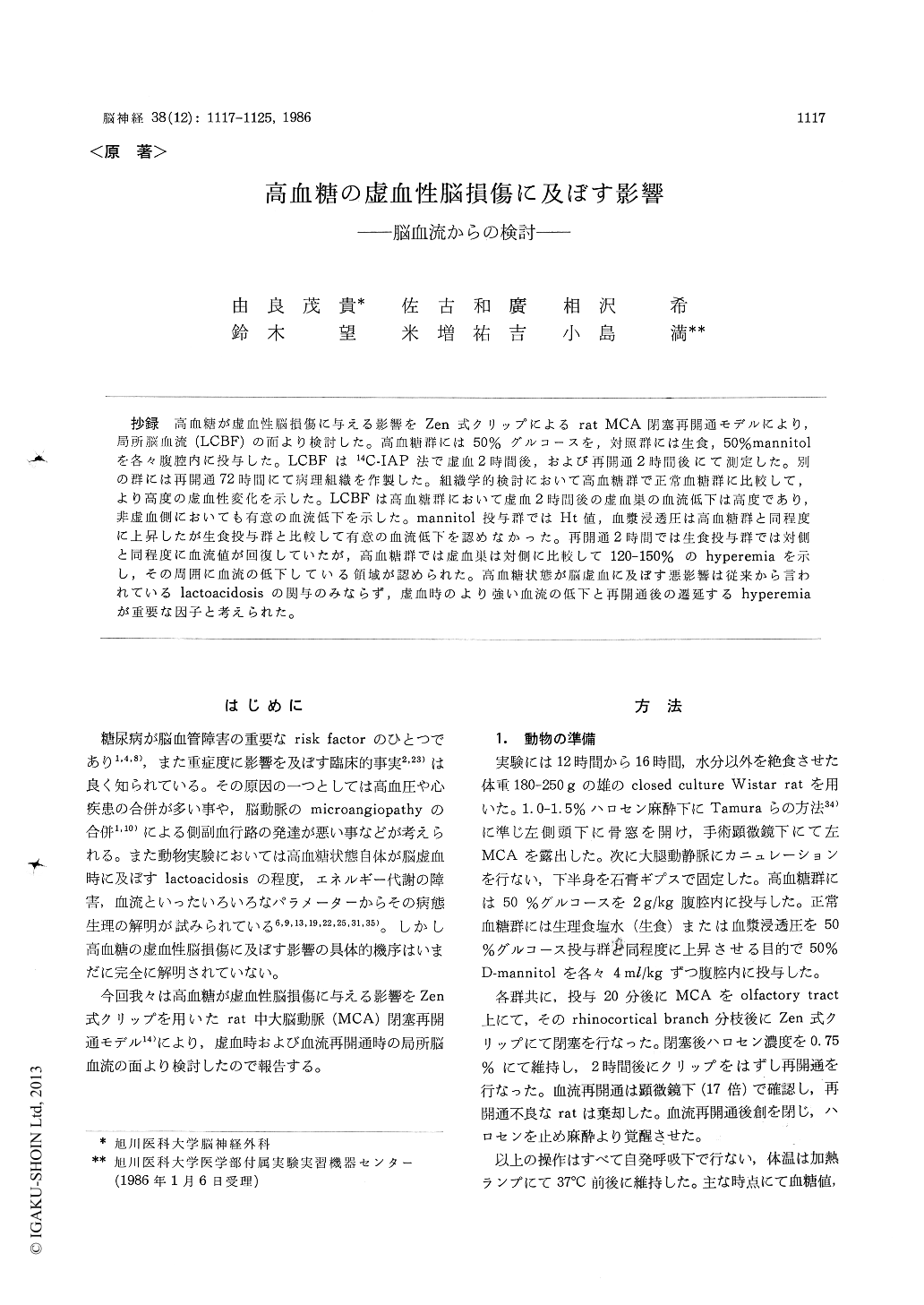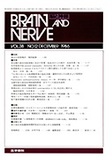Japanese
English
- 有料閲覧
- Abstract 文献概要
- 1ページ目 Look Inside
抄録 高血糖が虚血性脳損傷に与える影響をZen式クリップによるrat MCA閉塞再開通モデルにより,局所脳血流(LCBF)の面より検討した。高血糖群には50%グルコースを,対照群には生食,50%mannitolを各々腹腔内に投与した。LCBFは14C-IAP法で虚血2時間後,および再開通2時間後にて測定した。別の群には再開通72時間にて病理組織を作製した。組織学的検討において高血糖群で正常血糖群に比較して,より高度の虚血性変化を示した。LCBFは高血糖群において虚血2時間後の虚血巣の血流低下は高度であり,非虚血側においても有意の血流低下を示した。mannitol投与群ではHt値,血漿浸透圧は高血糖群と同程度に上昇したが生食投与群と比較して有意の血流低下を認めなかった。再開通2時問では生食投与群では対側と同程度に血流値が回復していたが,高血糖群では虚血巣は対側に比絞して120-150%のhyperemiaを示し,その周囲に血流の低下している領域が認められた。高血糖状態が脳虚血に及ぼす悪影響は従来から言われているlactoacidosisの関与のみならず,虚血時のより強い血流の低下と再開通後の遷延するhyperemiaが重要な因子と考えられた。
The effect of hyperglycemia on ischemic brain damage in rats was studied by measuring the local cerebral blood flow (LCBF) using a transient middle artery (MCA) occlusion model.
Rats, fasted except for water for 12-16 hours, were used. They were anesthetized with halo-thane and the stem of the left MCA was occluded for 2 hours by a microclip. Reperfusion was per-formed by removal of the clip. The rats were awaken from anesthesia after removal of the clip. Hyperglycemia was induced by intraperitoneal injection of 50% glucose and same volume of 50%D-mannitol or physiological saline were injected intraperitoneally 20 minutes before MCA occlusion in control rats. LCBF was measured by quantita-tive autoradiography using 14C-iodoantipyrine 2 hours after clipping and 2 hours after reperfusion. Some rats were prepared for neuropathological observation 72 hours after reperfusion.
In hyperglycemic rats, plasma glucose concen-tration rose to over 500 mg/dl at the peak. A hyperglycemic state around 300 mg/dl was maintained during the experiments. Elevation of hematocrit and plasma osmolarity to the same degree were observed in both hyperglycemic and mannitol pretreated rats.
On histological study ischemic neuronal cell da-mage was found to be more extensive in hyper-glycemic rats than in the saline pretreated rats. At 2 hours after MCA occlusion, LCBF in the ischemic focus decreased significantly in hyper-glycemic rats compared with the control. The reduction of LCBF was observed also in the con-tralateral non-ischemic side (P<0. 05). On the other hand, in the mannitol pretreated rats, ischemic change was slightly stronger than those in the saline pretreated rats, however, a reduction of LCBF in the non-ischemic side in comparison with those in the saline pretreated rats was noted without statistical significance. At 2 hours after reperfusion, LCBF in the ischemic side re-covered to 80-100% of that in the contralateral side in the saline pretreated rats. However, in hyperglycemic rats, hyperemia up to 120-150% of the contralateral LCBF was observed in the pre-viously ischemic area with a halo of reduced CBF area. The halo of reduced CBF area surrounding the hyperemic area was thought to be a result of a steal phenomenon by the hyperemic area or a reduction of perfusion pressure due to the blood volume expansion or excessive accumulation of water (brain edema) in the hyperemic area.
The most popular explanation for the delete-rious effect of hyperglycemia on ischemic brain damage is the excessive accumulation of lactic acid produced by anaerobic glycolysis during ischemia. However, the detailed mechanism is still obscure. Our data suggests that the mecha-nisms of increased ischemic brain damage in hyper-glycemia are a exaggerated reduction of cerebral blood flow during ischemia and prolonged hyper-emia after reperfusion probably due to a pro-longed tissue lactoacidosis. The existence of a halo of hypoperfusion surrounding the hyperemic area after reperfusion was presumed to be a pos-sible explanation for the aggravation of ischemic change in hyperglycemia.

Copyright © 1986, Igaku-Shoin Ltd. All rights reserved.


